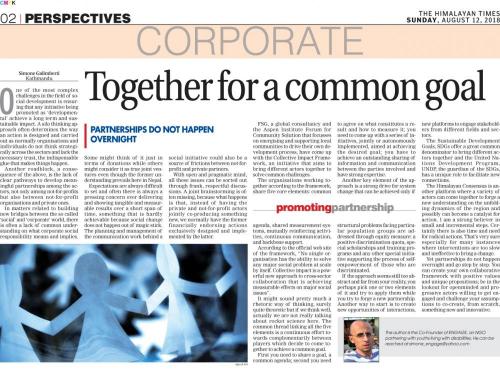
One of the most complex challenges in the field of social development is ensuring that any initiative being promoted as “developmental” achieve a long term and sustainable impact.
A silo thinking approach often determines the way an action is designed and carried out as normally organizations and individuals do not think strategically across the sectors and lack the necessary trust, the indispensable glue that makes things happen.
Another roadblock, a consequence of the above, is the lack of clear pathways to develop meaningful partnerships among the actors, not only among not for profits but also between not for profit organizations and private ones.
In matters related to building new bridges between the so called “social” and “corporate” world, there is often a lack of common understanding on what corporate social responsibility means and implies.
Some might think of it just in terms of donations while others might consider it as true joint ventures even though the former understanding prevails here in Nepal.
Expectations are always difficult to set and often there is always a pressing concern over delivering and showing tangible and measurable results over a short span of time, something that is hardly achievable because social change does not happen out of magic stick.
The planning and management of the communication work behind a social initiative could also be a source of frictions between not for profit and private partners.
With open and pragmatic mind, all these issues can be sorted out through frank, respectful discussions.
A joint brainstorming is often missing, because what happens is that, instead of having the private and not for profit actors jointly co-producing something new, we normally have the former financially endorsing actions exclusively designed and implemented by the latter.
FSG, a global consultancy and the Aspen Institute Forum for Community Solution that focuses on energizing and supporting local communities to drive their own development process, have come up with the Collective Impact Framework, an initiative that aims to bring different actors together to solve common challenges.
The organizations working together according to the framework, share five core elements: common agenda, shared measurement systems, mutually reinforcing activities, continuous communication, and backbone support.
According to the official web site of the framework, “No single organization has the ability to solve any major social problem at scale by itself. Collective impact is a powerful new approach to cross-sector collaboration that is achieving measurable effects on major social issues”.
It might sound pretty much a rhetoric way of thinking, surely quite theoretic but if we think well, actually we are not really talking about rocket science here.
The common thread linking all the five elements is a continuous effort towards complementarity between players which decide to come together to achieve a common goal.
First you need to share a goal, a common agenda; second you need to agree on what constitutes a result and how to measure it; you need to come up with a series of initiatives, jointly or autonomously implemented, aimed at achieving the desire goal; you have to achieve an outstanding sharing of information and communication between the parties involved and lastly you need to have strong expertise.
Another key element of the approach is a strong drive for system change that can be achieved only if structural problems facing particular population groups are addressed through equity measure: a positive discrimination quota, special scholarships and training programs and any other special initiative supporting the process of self-empowerment of those who are discriminated.
If the approach seems still too abstract and far from your reality, you perhaps pick one or two elements of it and try to apply them while you try to forge a new partnership.
Another way to start is to create new opportunities of interactions, new platforms to engage stakeholders from different fields and sectors.
The Sustainable Development Goals, SDGs offer a great common denominator to bring different actors together and the United Nations Development Program, UNDP, the guardian of the SDGs, has a unique role to facilitate new connections.
The Himalayan Consensus is another platform where a variety of actors can come together to forge a new understanding on the unfolding dynamics of the region and possibly can become a catalyst for action.
I am a strong believer in small and incremental steps.
Certainly there is also time and need for radical actions. That’s very sure especially for many instances where interventions are too slow and ineffective to bring a change.
Yet partnerships do not happen overnight and go step by step.
You can create your own collaborative framework with positive values and unique propositions and be in the lookout for some open mind and progressive actors willing to get engaged and constructively challenge your assumptions to co-create, from scratch, something very new and innovative.










Add new comment